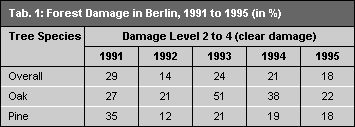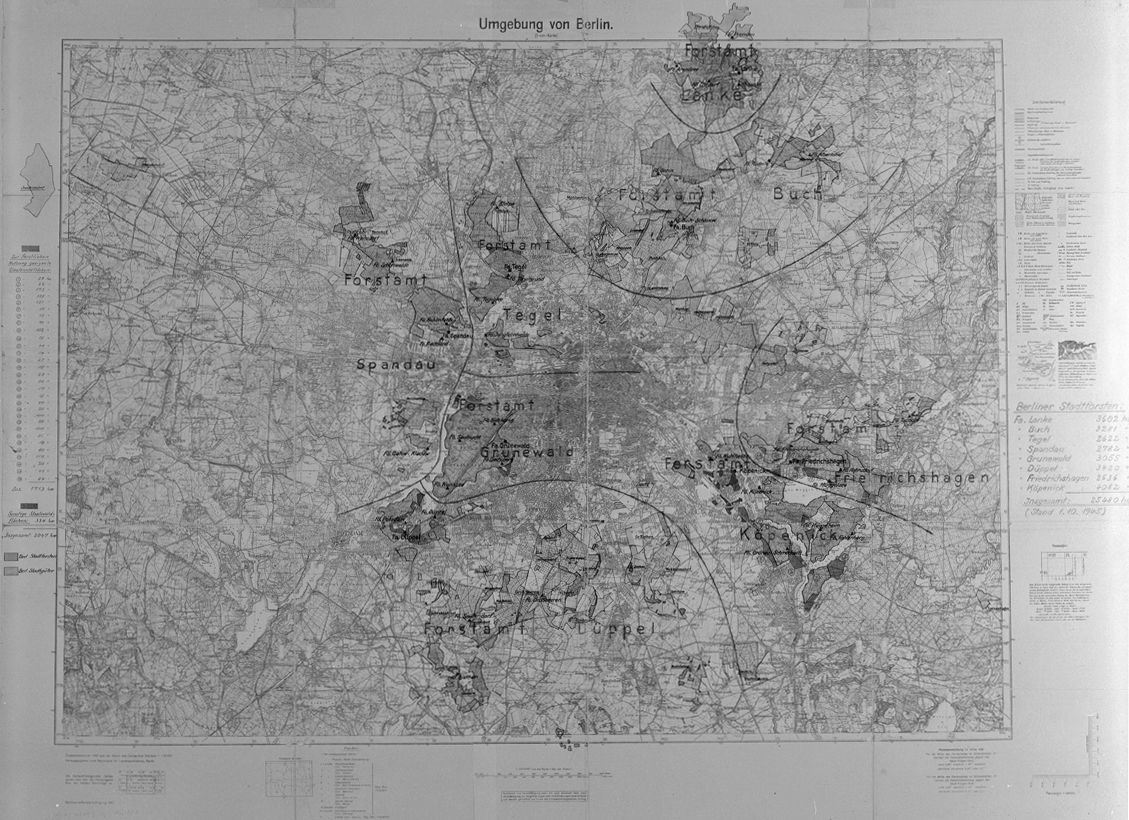In the course of the Second World War, the Berlin forests were greatly damaged. Between 1937 and 1944, twice as much wood was cut “to strengthen raw material supply” in Berlin, as would have been sensible from the point of view of forestry planning – 150,000 solid cubic meters per year (fm/a) instead of 71,000 fm/a. At the same time, the planting of new trees was neglected, and thus the principle of sustainability abandoned (cf. SenStadtUm 1995a). This systematic depletion increased still more during the last two years of the war: For the defense against the advancing Allies, a large number of trees was indiscriminately felled by the Wehrmacht, leaving behind extensive desolation. But also large-scale theft of firewood, both by the Wehrmacht and by the population, did great damage to the forest (570,000 fm during 1945-‘46).
With the end of the Second World War, a period of different development of the forests began in the eastern and western parts of the city, as well as in the districts located outside the city.
In West Berlin, after the war’s end and the ensuing blockade (1948-‘49), approx. 45 % of the original wooded areas had been cleared and/or greatly thinned. For lack of other plant material, mainly pines were used for the extensive reafforestation of the barren areas. This is reason today for the relatively high proportion of approx. 45-year-old pine monocultures.
Since the beginning of the 50s, the West Berlin forestry institutions have been promoting the transformation of the forest by deciduous underwood seeding and planting in clearings in stands of clear, old trees, as a step in direction of a mixed forest. The goal has been forestry on the basis of a selection forest, and the development of a permanent forest. At the same time, however, such florally foreign tree species as larch, Douglas fir, Weymouth pine and red oak were also introduced by hurst and cluster into the stock. The 1979 State Forest Law and the 1982 Basic Forestry Plan for the Berlin Forests were oriented toward a naturally compatible operation of the Berlin forests. The most important goals of these operational guidelines were:
- an increase in the deciduous share from 40 % to 60 %;
- the development of a richly-structured mixed forest;
- the improvement of the conservation and landscape care;
- a 1-ha limit on clear-cutting;
- the adoption of natural regeneration; and
- to dispense with the use of herbicides and improvement measures.
The forest lands in East Berlin developed differently. The destruction of the old growth had not been as extensive as in the western part of the city. Those trees which, by the end of the war, had surpassed pole-timber age, but not yet reached felling maturity, were not subjected to harvesting during the ‘50s to the same extent as in West Berlin. This affects many areas in the districts south of the Müggelsee Lake. Thus, the old-growth proportion (stocks over 80 years old) was able to grow to 53 % by 1975. In addition, the rotation age has been raised for pines from 100 to 120 since 1975. The result was a deficit in wood production, which was tolerated out of consideration for the recreational function of the Berlin forests. Due to the staged clear-cutting of the pines, wooded areas were characterized predominantly by the structures typical of an age-class forest. Thus, the Berlin forests assumed a special place in East Germany. They received a recreational
function, in addition to the primary role of raw material production.
Forestry in East Germany was greatly centralized. This was further intensified during the ’70s. The goals were maximum increase in domestic wood production and the transition to industrial production methods. In the Berlin forests, the following measures were to be carried out:
- removal of all low-production stocks;
- no toleration of afforestation delays;
- fertilization and melioration measures; and
- restoration of a normal age structure (i.e., removal of the high old-growth proportion).
Because of the goal of multiple use of the Berlin forests, these guidelines could be somewhat diluted. The forest was broken down into classes of recreational functions. Maximum allowable clear-cut areas were established. For instance clear-cutting was forbidden at recreational centers. In recreational park forests, clear-cutting up to 3 ha was allowed; in normal economic-use forests, clear-cutting was allowed up to 10 ha. In the areas of the former city forests outside the city limits, economic management was, however, carried out according to the guidelines of optimal economic use.
As early as the ’60s, smoke-damage investigations were carried out in the East Berlin forests, and damage to the trees was ascertained. As a result, a smoke-damage area amounting to 36 % of the total area was certified in 1974 (by 1975, it was already 43 %). For “revitalization,” damaged pine forests were fertilized with nitrates. Between 1977 and the cessation of fertilization in 1985, 100 to 800 kg of nitrogen/ha were spread in the Fahlenberg and Müggelheim Districts.
A major problem in the East Berlin forest is the wide dissemination of chee-reed grass (Calamagrostis epigeios), which complicates natural regeneration. Its center of dissemination is found particularly in the relatively clear, single-layer pine stands which are free of a shrub layer and of medium age. The spread was furthered through the former practice the clear-cutting and complete replowing, and the fertilization of the forests.
In the Northeast of the city, large former sewage-farm areas were transferred to the Berlin Forestry Operation in 1985 and afforested on the occasion of the 750-year anniversary festival of the founding of Berlin. This was carried out under heavy deadline pressure and without sufficient preliminary examinations, with the goal of the creation a recreational forest. After grading, the sewage farms were planted predominantly mechanically with over 50 different tree and shrub species, such as poplar, mountain ash, birch, alder, European beech, pine and spruce. The site problems, including heavy-metal pollution, the disturbed soil surface and ground-water conditions, and a mistaken selection of tree species (including decorative trees and shrubs) resulted in unsatisfactory growth results and poor stock vitality (cf. SenStadtUm 1995a).
The abundant dissemination the durmast oak, which was introduced about 100 years ago from North America, presents a considerable Berlin-wide problem, since it suppresses natural regeneration of florally-appropriate tree species, and the development of a herbaceous layer. In the former West Berlin, it has been increasingly cleared since 1985. Its removal from the stock is one of the essential tasks in the Berlin forest.
In 1992, the Berlin Forests published the Forestry Guidelines for Greater Berlin, which brings together the interests of forestry, conservation, recreational use and landscape esthetics to form a uniform concept for action. The orientation is toward careful, sustainable and naturally appropriate forestry. To preserve the climatic, hydrological, hydrochemical and public-health effects of forest areas, extensive measures for the protection and development of near-natural forest structures with rich animal and plant life are carried out in the entire wooded area.
Wood production, otherwise a main task of forestry, will over the long term take a back seat to regional-cultural and social functions. The forests emerging in the future should contain a web of all stages of development, from the regeneration through the aged phase. Important structural elements, like standing deadwood or glades, should exist in sufficient quantity and quality and be distributed throughout the entire wooded area, and/or should emerge anew. The essential criteria for a natural management of the Berlin forest are:
- Gradual reduction of the florally foreign tree species;
- Planting of site-appropriate and florally appropriate tree species;
- Stock renewal through advancement of natural regeneration;
- Promotion of mixed stands with rich structural and species diversity;
- Renunciation on firm rotation times; felling is to be carried out after trees reach their target size;
- Selective, tree-by-tree wood harvesting;
- Abandonment of clear-cutting;
- Protection of hollows and nest-trees;
- An increase in the proportion of deadwood;
- No complete replowing of areas; and
- Renunciation of fertilizer and pesticides (cf. SenStadtUm 1992).
The Berlin Forests in 1990 applied to the Trust Agency for the restoration of approx. 10,750 ha of former Berlin city forest land in Brandenburg. Up to now 9,179 ha of these areas have been restored to the Berlin Forests (as of October 1995). Map 4 shows the new districts Gorin, Stolpe and Wansdorf as well as the Parforce Heath, which is attached to the Dreilinden District.


